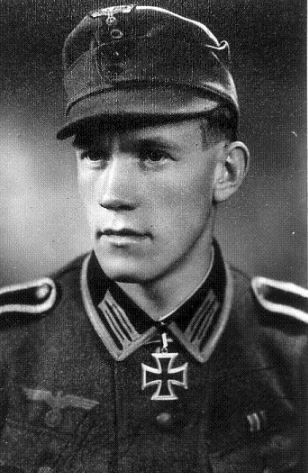Drexel, Johann (Grenadier-Regiment 408)
- Date of birth:
- December 20th, 1919 (Oberreute im Allgäu/Bavaria, Germany)
- Date of death:
- February 9th, 2004 (Günzburg/Bavaria, Germany)
- Nationality:
- German
Biography
Johann Drexel finally reached the rank of Feldwebel.
Do you have more information about this person? Inform us!
- Period:
- Second World War (1939-1945)
- Period:
- Second World War (1939-1945)
- Period:
- Second World War (1939-1945)
- Awarded on:
- 1942
- Period:
- Second World War (1939-1945)
- Rank:
- Unteroffizier (Junior Officer)
- Unit:
- Geschutzführer, 14 (Panzerjäger) Kompanie, Grenadier-Regiment 408, 121. Infanterie-Division
- Awarded on:
- August 23rd, 1943
“Soviet breakthrough prevented with 4 men, and 12 enemy tanks destroyed while doing so:
On the 07.08.1943 a major assault by the Soviets again took place in the Sshussna area. They wished to breakthrough towards the road and block the railway line from Jelna to Suginitschi.
At 03:30 the enemy’s drumfire began without warning, and the assault itself began after three hours of this. The smoke from the detonated shells and the scattered smoke rounds made us effectively blind.
Suddenly the noise of an enemy tank gun emerged among the various battle noises. At the same time it was also possible to identify a muzzle flash through the smoke and mist. I shouted to my no. 1 to fire upon this enemy target. He looked through the gunner’s sight but could not spot the target. I thus personally took up this position, peered through the gunsight (which had been dirtied by the bombardment) and set up the emergency sight. At the same time I opened fire upon the oncoming enemy tank, which had by now gotten to a distance of 100 metres. It was struck by the first shot and ground to a halt.
In the meantime visibility had improved and we saw an additional 4 tanks coming up, all T-34s. We immediately opened fire on the first one. The wave of tanks stopped. The last one fell out of formation and tried to run over my cannon. There was an immediate exchange of fire. I was able to knock out the T-34 by a shot to the turret ring when it was 30 metres in front of my position. The 3 other enemy tanks had been giving covering fire to the first, and their shots were landing dangerously close. Now I once again took up the battle with these. After a short firefight I was also able to put these out of commission. With this the first wave of enemy armour was defeated.
Now the escorting infantry ran against my position, but I broke up this attack with high explosive rounds. Now the second enemy tank wave came up. A high explosive round was still loaded and I wanted to expend this shot; I fired, but the shell did not leave the gun. The round was stuck in the chamber. ‘Get the faulty shot out.’ My no. 1 opened up the breechblock. The cartridge was taken out, however the shell itself was still stuck in the barrel. I tore the cleaning rods from the gun trail, screwed them together and jumped to the front of the gun. By repeatedly pushing the cleaning rods through the muzzle against the chamber it was possible to force the round out through the rear.
After immediately jumping back into position I opened fire on the first 3 tanks. These were a KV-1, a T-34 and a ‘General Sherman’. The KV-1 and T-34 lay still after a few rounds. The American one was behind the first four and began to fire at me. I similarly shot against him, but could only see the turret as this tank was concealed behind another knocked out tank. My fire now persuaded this tank to reverse behind this row of knocked out armour every time. As soon as he had reached a gap he fired, and I did likewise. The duel lasted in this way for a few minutes, the longest I had experienced in my life. After several rounds of back and forth driving he suddenly rumbled too far to the right. I could see its chassis and placed a round in its flank. The track came off and it continued to turn. My next round struck the hull and the ‘Sherman’ burned. With this the second hostile armoured attack had been crushed.
Our infantry had taken heavy losses under the enemy fire, and had left their positions. Only myself, my men and our cannon were still involved in the defensive battle. Just before the Soviets renewed their attack I succeeded in bringing a light machine-gun into position, and with its support we also smashed this attack. The 4 enemy tanks that escorted this attack were likewise knocked out, bringing my total of tanks destroyed to 12.
This entire battle lasted only 40 minutes, and ended at 07:15. In the hours before midday the Soviets still made a few attempts to take out my cannon with small groups, however I was also able to master these engagements and hold the sector. But unfortunately my gun received a direct hit just before midday, and two of my best men became casualties. I was now forced to leave the position and seek out contact with the Regiment. By now it had reorganized and was holding its ground in a renewed defensive battle at the third line.
My steadfastness had given the Regiment the time it needed to reorder itself, and it thus significantly contributed to the success of the defensive battle.”






